(完整word版)初中语法精讲讲义(全)
- 格式:doc
- 大小:1.02 MB
- 文档页数:52
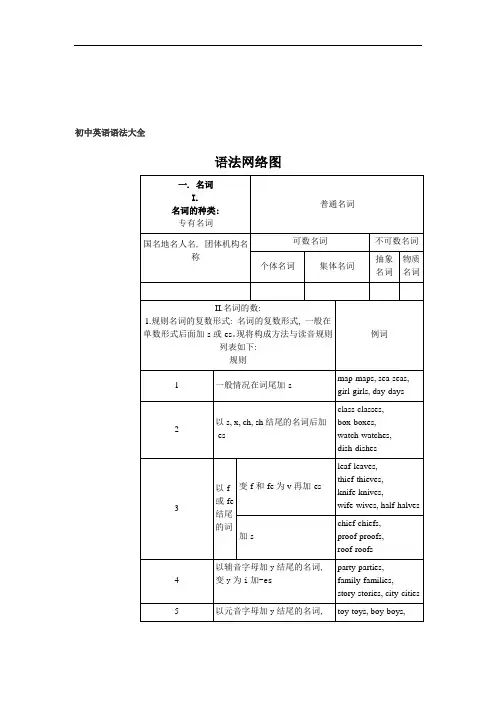
初中英语语法大全语法网络图十二。
倒装句十三。
虚拟语气十四。
重要句型1.It was not until midnight that he finished his task.2.Not until he came back from abroad was I able to see him again. 3.The harder you work, the greater progress you will make.4.He walked around the house, gun in hand.5.May you be in good health!6.Wish you a pleasant journey back home!7.The professor was a humorous man with big nose and deep-set eyes.8.What surprised me most was his imagination and patience.9.He lay on the grass, with his eyes looking at the sky and his hands under his head. 10.Sitting under the tree are Mr.Green and his first teacher.11.On the wall hang two pictures of famous scientists.12.Looking back upon those past years, he couldn’t help feeling very proud.13.No sooner(Hardly) had he arrived at the theatre than(when) the play started.14.Young as he is, he has learned advanced mathematics.15.How I regret the hours wasted in the woods and fields!16.There stands a beautiful vase in the corner of the room.17.Ten miles north of the town lies a paper factory.18.There goes the bell.19.Nowhere has the world ever seen such a bird as here.20.It is no use crying for help.21.If only I had been your student in the middle school!22.It is believed that such a thing will not happen again.23.Only when he explained did I realize the reason for this.24.“He works particularly hard.”“So he does, and so do you.”25.Not only Alice but also Jane and Mary are tired of having one examination after another.26.Such was Albert Einstein, a simple person of great achievements.十五。
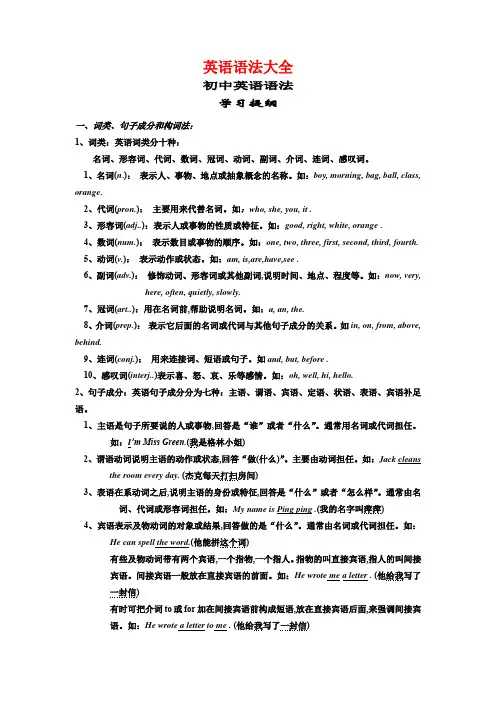
英语语法大全初中英语语法学习提纲一、词类、句子成分和构词法:1、词类:英语词类分十种:名词、形容词、代词、数词、冠词、动词、副词、介词、连词、感叹词。
1、名词(n.):表示人、事物、地点或抽象概念的名称。
如:boy, morning, bag, ball, class, orange.2、代词(pron.):主要用来代替名词。
如:who, she, you, it .3、形容词(adj..):表示人或事物的性质或特征。
如:good, right, white, orange .4、数词(num.):表示数目或事物的顺序。
如:one, two, three, first, second, third, fourth.5、动词(v.):表示动作或状态。
如:am, is,are,have,see .6、副词(adv.):修饰动词、形容词或其他副词,说明时间、地点、程度等。
如:now, very,here, often, quietly, slowly.7、冠词(art..):用在名词前,帮助说明名词。
如:a, an, the.8、介词(prep.):表示它后面的名词或代词与其他句子成分的关系。
如in, on, from, above, behind.9、连词(conj.):用来连接词、短语或句子。
如and, but, before .10、感叹词(interj..)表示喜、怒、哀、乐等感情。
如:oh, well, hi, hello.2、句子成分:英语句子成分分为七种:主语、谓语、宾语、定语、状语、表语、宾语补足语。
1、主语是句子所要说的人或事物,回答是“谁”或者“什么”。
通常用名词或代词担任。
如:I’m Miss Green.(我是格林小姐)2、谓语动词说明主语的动作或状态,回答“做(什么)”。
主要由动词担任。
如:Jack cleansthe room every day. (杰克每天打扫房间)3、表语在系动词之后,说明主语的身份或特征,回答是“什么”或者“怎么样”。
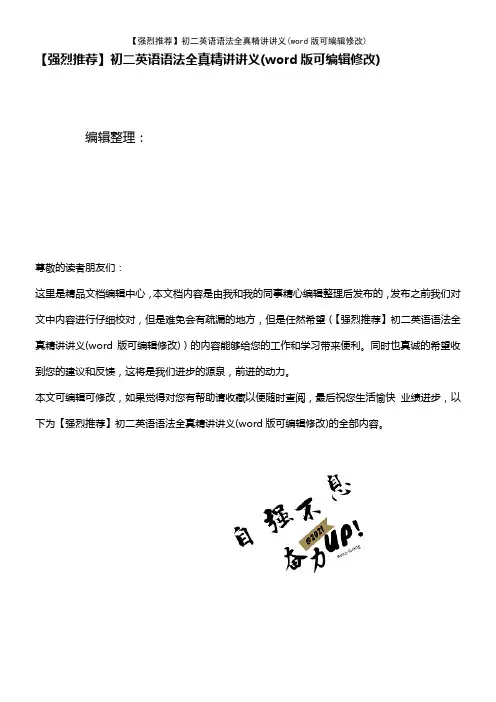
【强烈推荐】初二英语语法全真精讲讲义(word版可编辑修改)编辑整理:尊敬的读者朋友们:这里是精品文档编辑中心,本文档内容是由我和我的同事精心编辑整理后发布的,发布之前我们对文中内容进行仔细校对,但是难免会有疏漏的地方,但是任然希望(【强烈推荐】初二英语语法全真精讲讲义(word版可编辑修改))的内容能够给您的工作和学习带来便利。
同时也真诚的希望收到您的建议和反馈,这将是我们进步的源泉,前进的动力。
本文可编辑可修改,如果觉得对您有帮助请收藏以便随时查阅,最后祝您生活愉快业绩进步,以下为【强烈推荐】初二英语语法全真精讲讲义(word版可编辑修改)的全部内容。
初二英语语法真题讲义主讲:王川欢迎使用新东方在线电子教材第二部分历届试题精选Unit 11. jack, good boy! Please pass ________ the glasses。
I want to read the newspaper.A. you B。
me C. him D。
her2.This morning I had ________ egg and a bottle of milk for my breakfast.A. anB. aC. the D。
不填冠词不定冠词定冠词零冠词morning.3。
—How many ________ can you see in the following pictures?—Three。
A. boysB. animalsC. films D。
buildings4。
Timmy goes to school ________ every day。
It’s 5 minutes’ walk from his home to school.A。
in a bus B. by plane C. on foot D. by boat5。
Everything is ________ at night markets. You don’t need a lot of money to have a good time.A。
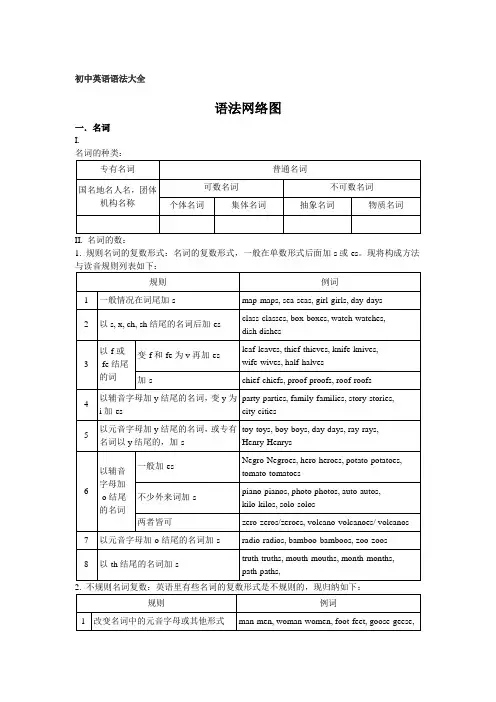
初中英语语法大全语法网络图一.名词I.名词的种类:1. 规则名词的复数形式:名词的复数形式,一般在单数形式后面加-s或-es。
现将构成方法与读音规则列表如下:III. 名词的所有格:名词在句中表示所有关系的语法形式叫做名词所有格。
所有格分两种:一是名词词尾加’s 构成,二是由介词of加名词构成。
前者多表示有生命的东西,后者多表示无生命的东西。
3. of所有格的用法:用于无生命的东西:the legs of the chair, the cover of the book用于有生命的东西,尤其是有较长定语时:the classrooms of the first-year students 用于名词化的词:the struggle of the oppressed二.冠词冠词分为不定冠词(a, an),定冠词(the),和零冠词。
I.不定冠词的用法:三.代词:I.代词可以分为以下七大类:II. 不定代词用法注意点:1. one, some与any:1) one可以泛指任何人,也可特指,复数为ones。
some多用于肯定句,any多用于疑问句和否定句。
One should learn to think of others.Have you any bookmarks? No, I don’t have any bookmarks.I have some questions to ask.2) some可用于疑问句中,表示盼望得到肯定的答复,或者表示建议,请求等。
Would you like some bananas?Could you give me some money?3) some 和any修饰可数名词单数时,some表示某个,any表示任何一个。
I have read this article in some magazine.Please correct the mistakes, if any.4) some和数词连用表示“大约”,any可与比较级连用表示程度。
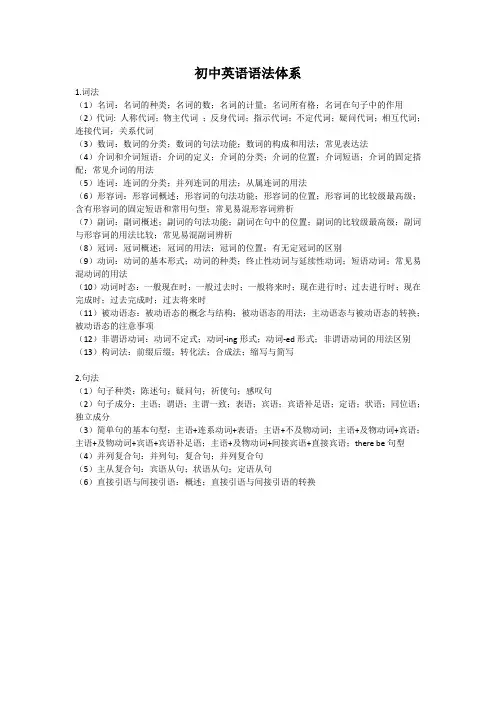
初中英语语法体系1.词法(1)名词:名词的种类;名词的数;名词的计量;名词所有格;名词在句子中的作用(2)代词: 人称代词;物主代词;反身代词;指示代词;不定代词;疑问代词;相互代词;连接代词;关系代词(3)数词:数词的分类;数词的句法功能;数词的构成和用法;常见表达法(4)介词和介词短语:介词的定义;介词的分类;介词的位置;介词短语;介词的固定搭配;常见介词的用法(5)连词:连词的分类;并列连词的用法;从属连词的用法(6)形容词:形容词概述;形容词的句法功能;形容词的位置;形容词的比较级最高级;含有形容词的固定短语和常用句型;常见易混形容词辨析(7)副词:副词概述;副词的句法功能;副词在句中的位置;副词的比较级最高级;副词与形容词的用法比较;常见易混副词辨析(8)冠词:冠词概述;冠词的用法;冠词的位置;有无定冠词的区别(9)动词:动词的基本形式;动词的种类;终止性动词与延续性动词;短语动词;常见易混动词的用法(10)动词时态:一般现在时;一般过去时;一般将来时;现在进行时;过去进行时;现在完成时;过去完成时;过去将来时(11)被动语态:被动语态的概念与结构;被动语态的用法;主动语态与被动语态的转换;被动语态的注意事项(12)非谓语动词:动词不定式;动词-ing形式;动词-ed形式;非谓语动词的用法区别(13)构词法:前缀后缀;转化法;合成法;缩写与简写2.句法(1)句子种类:陈述句;疑问句;祈使句;感叹句(2)句子成分:主语;谓语;主谓一致;表语;宾语;宾语补足语;定语;状语;同位语;独立成分(3)简单句的基本句型:主语+连系动词+表语;主语+不及物动词;主语+及物动词+宾语;主语+及物动词+宾语+宾语补足语;主语+及物动词+间接宾语+直接宾语;there be句型(4)并列复合句:并列句;复合句;并列复合句(5)主从复合句:宾语从句;状语从句;定语从句(6)直接引语与间接引语:概述;直接引语与间接引语的转换。
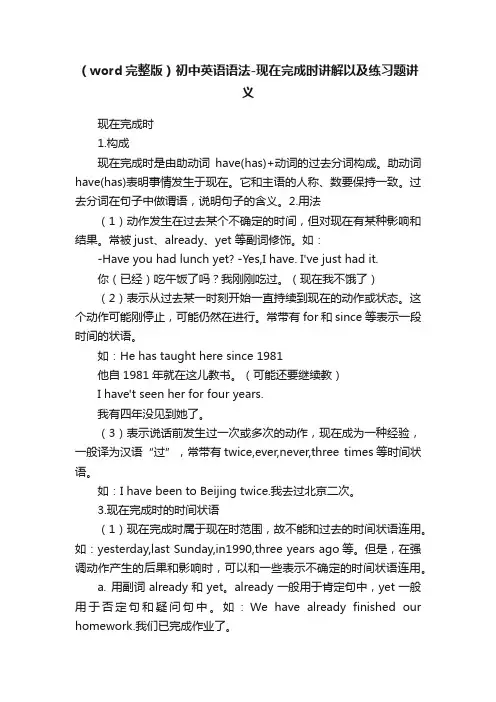
(word完整版)初中英语语法-现在完成时讲解以及练习题讲义现在完成时1.构成现在完成时是由助动词have(has)+动词的过去分词构成。
助动词have(has)表明事情发生于现在。
它和主语的人称、数要保持一致。
过去分词在句子中做谓语,说明句子的含义。
2.用法(1)动作发生在过去某个不确定的时间,但对现在有某种影响和结果。
常被just、already、yet 等副词修饰。
如:-Have you had lunch yet? -Yes,I have. I've just had it.你(已经)吃午饭了吗?我刚刚吃过。
(现在我不饿了)(2)表示从过去某一时刻开始一直持续到现在的动作或状态。
这个动作可能刚停止,可能仍然在进行。
常带有for和since等表示一段时间的状语。
如:He has taught here since 1981他自1981年就在这儿教书。
(可能还要继续教)I have't seen her for four years.我有四年没见到她了。
(3)表示说话前发生过一次或多次的动作,现在成为一种经验,一般译为汉语“过”,常带有twice,ever,never,three times等时间状语。
如:I have been to Beijing twice.我去过北京二次。
3.现在完成时的时间状语(1)现在完成时属于现在时范围,故不能和过去的时间状语连用。
如:yesterday,last Sunday,in1990,three years ago等。
但是,在强调动作产生的后果和影响时,可以和一些表示不确定的时间状语连用。
a. 用副词already和yet。
already一般用于肯定句中,yet一般用于否定句和疑问句中。
如:We have already finished our homework.我们已完成作业了。
They haven't finished their homework yet.他们还没有完成作业。
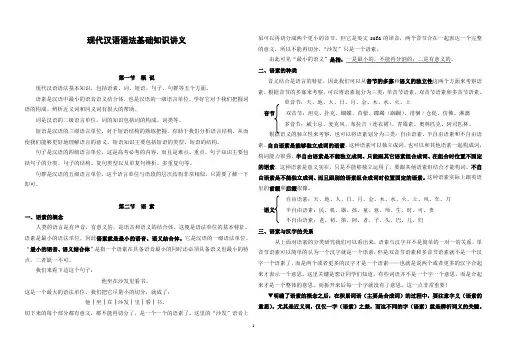
现代汉语语法基础知识讲义第一节概说现代汉语语法基本知识,包括语素、词、短语、句子、句群等五个方面。
语素是汉语中最小的语音语义结合体,也是汉语的一级语言单位。
学好它对于我们把握词语的构成、辨析近义词和同义词有很大的帮助。
词是汉语的二级语言单位。
词的知识包括词的构成、词类等。
短语是汉语的三级语言单位,对于短语结构的熟练把握,有助于我们分析语言结构,从而使我们能够更好地理解语言的意义。
短语知识主要包括短语的类型、短语的结构。
句子是汉语的四级语言单位,这是高考必考的内容,而且是难点、重点。
句子知识主要包括句子的分类、句子的结构、复句类型以及单复句辨析、多重复句等。
句群是汉语的五级语言单位,这个语言单位与语段的层次结构非常相似,只需要了解一下即可。
第二节语素一、语素的概念人类的语言是有声音、有意义的,是语音和语义的结合体,这便是语法单位的基本特征。
语素是最小的语法单位,因此语素就是最小的语音、语义结合体。
它是汉语的一级语法单位。
“最小的语音、语义结合体”是指一个语素在具备语音最小的同时还必须具备语义也最小的特点,二者缺一不可。
我们来看下边这个句子:他坐在沙发里看书。
这是一个最大的语法单位,我们把它尽量小的切分,就成了:他│坐│在│沙发│里│看│书。
切下来的每个部分都有意义,都不能再切分了,是一个一个的语素了。
这里的“沙发”语音上素。
自由语素是能够独立成词的语素。
这种语素可以独立成词,也可以和其他语素一起构成词,构词能力很强。
半自由语素是不能独立成词、只能跟其它语素组合成词、在组合时位置不固定的语素。
这种语素是意义实在,只是不能够独立运用了,要跟其他语素组结合才能构词。
不自由语素是不能独立成词、而且跟别的语素组合成词时位置固定的语素。
这种语素实际上跟英语根据语法功能来考察,词可以分为实词和虚词两大类。
能够充当句子成分的词叫实词。
实词都有词汇意义。
不能充当句子成分,只能帮助实词造句、表示语法意义的词,叫虚词。
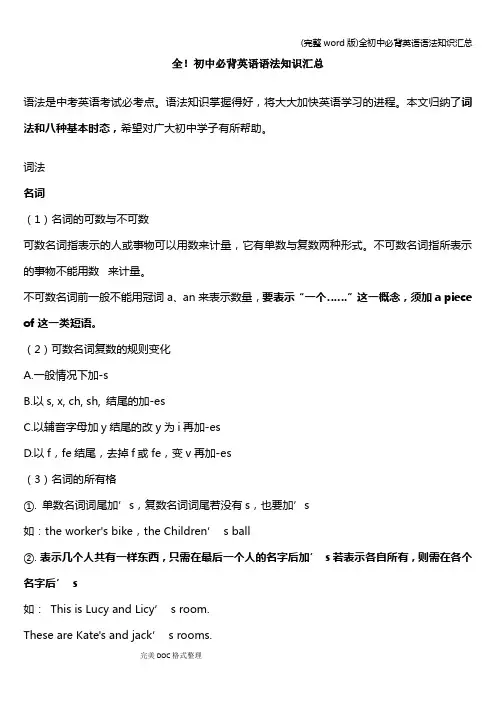
全!初中必背英语语法知识汇总语法是中考英语考试必考点。
语法知识掌握得好,将大大加快英语学习的进程。
本文归纳了词法和八种基本时态,希望对广大初中学子有所帮助。
词法名词(1)名词的可数与不可数可数名词指表示的人或事物可以用数来计量,它有单数与复数两种形式。
不可数名词指所表示的事物不能用数来计量。
不可数名词前一般不能用冠词a、an来表示数量,要表示“一个……”这一概念,须加a piece of这一类短语。
(2)可数名词复数的规则变化A.一般情况下加-sB.以s, x, ch, sh, 结尾的加-esC.以辅音字母加y结尾的改y为i再加-esD.以f,fe结尾,去掉f或fe,变v再加-es(3)名词的所有格①. 单数名词词尾加’s,复数名词词尾若没有s,也要加’s如:the worker's bike,the Children’s ball②.表示几个人共有一样东西,只需在最后一个人的名字后加’s若表示各自所有,则需在各个名字后’s如:This is Lucy and Licy’s room.These are Kate's and jack’s rooms.③. 如果是通过在词尾加—s构成的复数形式的名词,只加’。
如:the students’books,the girls’blouses代词(1)人称代词第一人称单数I me my mine myself复数we us our ours ourselves第二人称单数you you your yours yourself复数you you your yours yourselves第三人称单数 he him his his himselfshe her her hers herselfit it its its itself复数they them their theirs themselves(2)物主代词物主代词的用法:形容词性物主代词后面一定要跟上一个名词;名词性物主代词可作主语、表语、宾语。
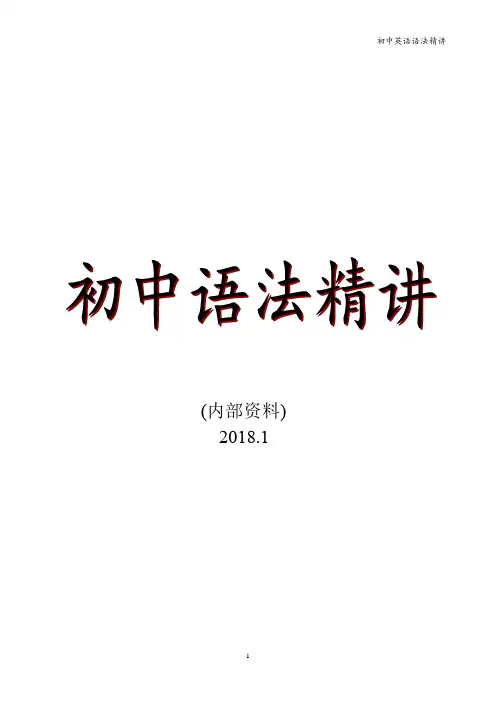
(内部资料) 2018.1目录第一讲名词第二讲冠词第三讲代词第四讲数词第五讲介词第六讲形容词和副词第七讲连词第八讲情态动词第九讲非谓语动词第十讲时态第十一讲被动语态第十二讲祈使句、倒装句、反意疑问句和感叹句第十三讲宾语从句第十四讲定语从句第十五讲状语从句第十六讲主谓一致第十七讲情景交际第十八讲词义辨析附录I 重点短语概述一、概述语法是研究词形变化和句子结构的科学,研究词形变化的部分成为词法(名词的数、格,动词的时态、语态),研究句子结构的部分称为句法(句子成分、语序,句子种类)。
二、英语词类词类英语作用在句中成分例词1名词n.表示人或物的名称主、宾、表、定、同位mother, son 2形容词adj.表示人或物的特征定、表、补、状big, small 3数词num.表示数目或顺序主、宾、nine, first 4代词pron.代替名词,数词主语宾语定语he, him, his 5动词v.表示动作或状态谓come, write 6副词adv.表示动作特征或性状特征状、表very, slowly 7冠词art.用在名词前说明其意义不做成分a, an, the8介词prep.用在名代前说明它与别的词之间的关系不做成分for, from, to 9连词conj.用来连接词与词或句与句不做成分and, but, if 10感叹词interj.表示说话时的感情或口气不做成分oh, ow三、句子成分句子中有两个最重要最基本的成分,主语和谓语。
除了主语和谓语,句子有时还有其他成分,宾语、定语、状语、表语等。
主语:一般位于句首,说明所要讲述的对象或主体,表示要说的“谁”或“什么”,一般由名词、代词或名词性的词类、短语或从句充当。
We often practise speaking English after class.Your father’s car is new.Watching English films is a good way to learn English.谓语:位于主语之后,说明主语的情况(动作或状态)---“做什么”“是什么”“怎么样”。
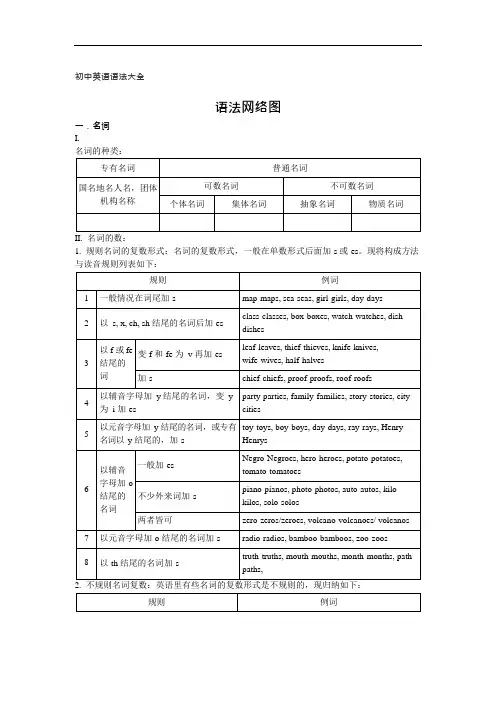
初中英语语法大全语法网络图一.名词I.名词的种类:II.名词的数:1.规则名词的复数形式:名词的复数形式,一般在单数形式后面加-s 或-es。
现将构成方法与读音规则列表如下:规则例词III.名词的所有格:名词在句中表示所有关系的语法形式叫做名词所有格。
所有格分两种:一是名词词尾加’s 构成,二是由介词of 加名词构成。
前者多表示有生命的东西,后者多表示无生命的东西。
2.’s 所有格的用法:3.of 所有格的用法:用于无生命的东西:the legs of the chair, the cover of the book用于有生命的东西,尤其是有较长定语时:the classrooms of the first-year students 用于名词化的词:the struggle of the oppressed二.冠词冠词分为不定冠词(a, an),定冠词(the),和零冠词。
I.不定冠词的用法:I.代词可以分为以下七大类:II. 不定代词用法注意点:1.one, some 与any:1)one 可以泛指任何人,也可特指,复数为ones。
some 多用于肯定句,any 多用于疑问句和否定句。
One should learn to think of others.Have you any bookmarks? No, I don’t have any bookmarks.I have some questions to ask.2)some 可用于疑问句中,表示盼望得到肯定的答复,或者表示建议,请求等。
Would you like some bananas?Could you give me some money?3)some 和any 修饰可数名词单数时,some 表示某个,any 表示任何一个。
I have read this article in some magazine.Please correct the mistakes, if any.4)some 和数词连用表示“大约”,any 可与比较级连用表示程度。
![初中语法精讲讲义[全]](https://uimg.taocdn.com/1d06ccbc6529647d27285246.webp)
(内部资料) 2018.1目录第一讲名词第二讲冠词第三讲代词第四讲数词第五讲介词第六讲形容词和副词第七讲连词第八讲情态动词第九讲非谓语动词第十讲时态第十一讲被动语态第十二讲祈使句、倒装句、反意疑问句和感叹句第十三讲宾语从句第十四讲定语从句第十五讲状语从句第十六讲主谓一致第十七讲情景交际第十八讲词义辨析附录I 重点短语概 述一、概述语法是研究词形变化和句子结构的科学,研究词形变化的部分成为词法(名词的数、格,动词的时态、语态), 研究句子结构的部分称为句法(句子成分、语序,句子种类)。
二、英语词类三、句子成分句子中有两个最重要最基本的成分,主语和谓语。
除了主语和谓语,句子有时还有其他成分,宾语、定语、状语、表语等。
主语:一般位于句首,说明所要讲述的对象或主体,表示要说的“谁”或“什么”,一般由名词、代词或 名词性的词类、短语或从句充当。
We often practise speaking English after class.Your father’s car is new.Watching English films is a good way to learn English.谓语:位于主语之后,说明主语的情况(动作或状态)---“做什么”“是什么”“怎么样”。
必须为动词或动词短语充当, 或由系动词加形容词、名词充当。
谓语与主语要保持人称和数一致。
I saw your brother yesterday.Tom will arrive in 10 minutes.She feels weak after a long illness.表语:位于系动词后,说明主语“是什么”“怎么样”,一般由形容词、名词充当。
构成主系表结构。
She is a teacher.The girl looks healthy.The cake tastes good.宾语:位于及物动词之后,说明动作、行为的对象或结果。
初中英语语法大全语法网络图一.名词I.名词的种类:1. 规则名词的复数形式:名词的复数形式,一般在单数形式后面加-s或-es。
现将构成方法与读音规则列表如下:III. 名词的所有格:名词在句中表示所有关系的语法形式叫做名词所有格。
所有格分两种:一是名词词尾加’s 构成,二是由介词of加名词构成。
前者多表示有生命的东西,后者多表示无生命的东西。
3. of所有格的用法:用于无生命的东西:the legs of the chair, the cover of the book用于有生命的东西,尤其是有较长定语时:the classrooms of the first-year students 用于名词化的词:the struggle of the oppressed二.冠词冠词分为不定冠词(a, an),定冠词(the),和零冠词。
I.三.代词:I.II. 不定代词用法注意点:1. one, some与any:1) one可以泛指任何人,也可特指,复数为ones。
some多用于肯定句,any多用于疑问句和否定句。
One should learn to think of others.Have you any bookmarks? No, I don’t have any bookmarks.I have some questions to ask.2) some可用于疑问句中,表示盼望得到肯定的答复,或者表示建议,请求等。
Would you like some bananas?Could you give me some money?3) some 和any修饰可数名词单数时,some表示某个,any表示任何一个。
I have read this article in some magazine.Please correct the mistakes, if any.4) some和数词连用表示“大约”,any可与比较级连用表示程度。
英语语法大全初中英语语法学习提纲一、词类、句子成分和构词法:1、词类:英语词类分十种:名词、形容词、代词、数词、冠词、动词、副词、介词、连词、感叹词。
1、名词(n。
):表示人、事物、地点或抽象概念的名称。
如:boy,morning, bag, ball,class,orange。
2、代词(pron。
):主要用来代替名词.如:who,she, you,it 。
3、形容词(adj。
.):表示人或事物的性质或特征.如:good,right,white, orange .4、数词(num。
): 表示数目或事物的顺序.如:one, two, three, first,second,third, fourth.5、动词(v.):表示动作或状态。
如:am,is,are,have,see .6、副词(adv.):修饰动词、形容词或其他副词,说明时间、地点、程度等.如:now, very, here,often,quietly,slowly。
7、冠词(art。
):用在名词前,帮助说明名词。
如:a, an, the。
8、介词(prep。
):表示它后面的名词或代词与其他句子成分的关系。
如in,on, from, above,behind.9、连词(conj.):用来连接词、短语或句子。
如and,but,before .10、感叹词(interj。
)表示喜、怒、哀、乐等感情。
如:oh, well, hi, hello。
2、句子成分:英语句子成分分为七种:主语、谓语、宾语、定语、状语、表语、宾语补足语。
1、主语是句子所要说的人或事物,回答是“谁”或者“什么".通常用名词或代词担任。
如:I'm Miss Green。
(我是格林小姐)2、谓语动词说明主语的动作或状态,回答“做(什么)”。
主要由动词担任。
如:Jack cleans the room everyday. (杰克每天打扫房间)3、表语在系动词之后,说明主语的身份或特征,回答是“什么”或者“怎么样”。
(内部资料) 2018.1目录第一讲名词第二讲冠词第三讲代词第四讲数词第五讲介词第六讲形容词和副词第七讲连词第八讲情态动词第九讲非谓语动词第十讲时态第十一讲被动语态第十二讲祈使句、倒装句、反意疑问句和感叹句第十三讲宾语从句第十四讲定语从句第十五讲状语从句第十六讲主谓一致第十七讲情景交际第十八讲词义辨析附录I 重点短语概述一、概述语法是研究词形变化和句子结构的科学,研究词形变化的部分成为词法(名词的数、格,动词的时态、语态),研究句子结构的部分称为句法(句子成分、语序,句子种类)。
二、英语词类词类英语作用在句中成分例词1 名词n. 表示人或物的名称主、宾、表、定、同位mother, son2 形容词adj. 表示人或物的特征定、表、补、状big, small3 数词num. 表示数目或顺序主、宾、nine, first4 代词pron. 代替名词,数词主语宾语定语he, him, his5 动词v. 表示动作或状态谓come, write6 副词adv. 表示动作特征或性状特征状、表very, slowly7 冠词art. 用在名词前说明其意义不做成分a, an, the8 介词prep. 用在名代前说明它与别的词之间的关系不做成分for, from, to9 连词conj. 用来连接词与词或句与句不做成分and, but, if10 感叹词interj. 表示说话时的感情或口气不做成分oh, ow三、句子成分句子中有两个最重要最基本的成分,主语和谓语。
除了主语和谓语,句子有时还有其他成分,宾语、定语、状语、表语等。
主语:一般位于句首,说明所要讲述的对象或主体,表示要说的“谁”或“什么”,一般由名词、代词或名词性的词类、短语或从句充当。
We often practise speaking English after class.Your father’s car is new.Watching English films is a good way to learn English.谓语:位于主语之后,说明主语的情况(动作或状态)---“做什么”“是什么”“怎么样”。
必须为动词或动词短语充当, 或由系动词加形容词、名词充当。
谓语与主语要保持人称和数一致。
I saw your brother yesterday.Tom will arrive in 10 minutes.She feels weak after a long illness.表语:位于系动词后,说明主语“是什么”“怎么样”,一般由形容词、名词充当。
构成主系表结构。
She is a teacher.The girl looks healthy.The cake tastes good.宾语:位于及物动词之后,说明动作、行为的对象或结果。
由名词或与之相当的其他词类、短语或从句充当。
I play the violin.The students are listening to the radio.We should learn from her.宾语补足语:位于宾语后,用来补充说明宾语的意义。
His words made her sad.Please call me Tom.I find it hard to speak French.定语:位置灵活,有前置定语,后置定语。
用来说明名词或代词性质、特点。
一般由形容词、介词短语,动词不定式或定语从句来充当。
China is a great country.The girl in red dress is my sister.The wild animals have no place to live.The man who smoked a lot died of lung cancer.状语:位于句首,句末或句中,用来修饰动词、形容词、副词或全句。
表示行为发生的时间、地点,目的、原因、方式、程度等。
通常由副词、介词短语、不定式或相当于副词作用的词来充当。
I often get up at six.The children are playing football in the playground.In order to catch the early bus, I had to get up early.He was late for school because of heavy traffic.Tim always goes to school by bus.It is raining heavily.第一讲 名词一、名词的类名词分类:根据意义分为专有名词和普通名词1)专有名词 表示具体的人、事物、地点和机构的专有名称。
2)普通名词 表示某人或某类事物的名称。
个体名词:表示单个的人或事物。
集体名词:表示一群人或一些事物的总称。
物质名词:表示无法分为个体的物质。
抽象名词:表示抽象概念(动作/状态/品质/感情)二、名词的数一、可数名词和不可数名词1)不可数名词 (不可用数字来计数,没有复数形式)①物质名词:无法分为个体, water, tea, bread, milk, rice, rain, snow,wind 注:有些物质名词可以具体化为可数名词 two teas有些不可数名词前有形容词修饰时,必须和a/an 连用 a heavy rain have a good time ②抽象名词:表示抽象概念(动作、状态、品质、感情) love, beauty, happiness, friendship2)可数名词 (可以用数字来计数,有单复数形式)单数可数名词要用冠词数词或其他限定词修饰,复数可数名词要在名词后面加s注:★常考不可数名词: advice information news knowledge furniture fun traffic progress可数名词: suggestion message idea3)有些名词既可以可数,也可以不可数,但意义不同。
不可数 可数 不可数 可数fish 鱼肉 鱼 chicken 鸡肉 小鸡 orange 橙汁 橙子room 空间 房间cloth 布料 抹布,桌布; clothes 衣服 work 工作 works 著作;works 工厂 light 光 灯exercise 锻炼 练习,习题;体操,操练 glass 玻璃 玻璃杯;眼镜(复) experience 经验 经历 wood 木头 woods 树林 success 成功 成功的人或事 paper 纸 试卷;论文;报纸 character 性格 主人公 sand 沙子sands 沙滩名 词专有名词 NBA Peter Coca Cola May Olympics Sunday普 通 名 词可数名词个体名词 desk book apple room 集体名词family group team class 不可数名词物质名词 water milk bread rice meat 抽象名词happiness friendship victory4) ★不可数名词的数量表达a piece of news two bottles of juice名词复数的变化规则读音---- “清清浊浊元后浊” 1. 在清辅音后 [s] 2. 在浊辅音和元音后 [z]3. 在[s] [z] [ʃ] [t ʃ] [d ʒ] 后[ɪz] classes roses brushes watches oranges(2)★不规则变化的名词复数形式①man —men woman —women policeman —policemen Englishman-- Englishmen Frenchman —Frenchmen ②foot —feet tooth —teeth goose--geese (鹅) ③child —children ox-oxen (牛) ④mouse--mice⑤单复同形 Chinese Japanese deer sheep fish (表种类时fishes) 注: ①国家人的复数变化:中日不变英法变,其余s 加后边。
*German-Germans②表示国籍时没有复数。
I ’m American, not English.③汉语音译词没有复数形式 100 yuan, 5 dollars (cents, pounds )(3)合成名词①一般将主体名词变复数。
mothers-in-law passers-by lookers-on ②无主体名词的在词尾变复数grown-ups 成年人 go-betweens 中间人③★以man, woman 开头的合成名词,所含的成分全都要变为复数。
man doctor----men doctors woman driver----women drivers(4) 单数形式的集体名词 具有复数意义,谓语动词用复数police, people(5) ★集体名词 class, family, group, team 表示个体成员--复数;表示整体-- 单数 My family (be) very poor when I was a child. My family (like) eating hot food.The class (be) reading when the teacher came in. My class (have) forty students.(6)复数名词①由两个对称部分构成的物品的名词,常用复数形式,谓语动词用复数,表示数量时用“数词+pair (s) of”glasses, trousers, jeans, shorts, pants, socks, shoes,②其他以复数形式出现的名词goods, woods, clothes三、名词所有格表示名词所有关系的形式叫名词所有格,译成“….的”,一般做定语。
三种形式:1. ’s形式 2. of 短语形式 3. 双重所有格1. ’s 所有格(用于表示有生命的人或物)(1)变化方法:①一般情况在名词词尾+’s John’s brother Children’s Day men’s clothes②以-s结尾的复数名词在词尾+’ students’ books two hours’ walk③共同拥有共同加Jane and Helen’s room (单数)分别拥有分别加Jane’s and Helen’s room s (复数)(2)所有格’s所修饰的名词可以省略①表示店铺、家等名词,如shop, home, office等可以省略。